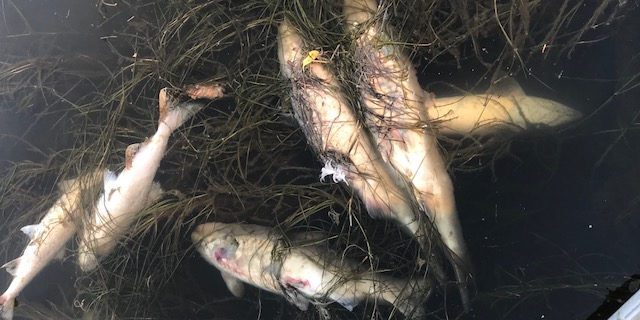Norton Sound residents have reported salmon die-offs in unusually large numbers during the last week. According to the Norton Sound Economic Development Corporation (NSEDC), dead pre-spawned pink salmon were found in multiple river systems over the weekend.
NSEDC’s Fisheries, Research, and Development Director Wes Jones says the numbers of humpies being reported are larger than what’s normally seen in the Norton Sound region, spread out across several communities from east to west.
“There’s been reports all the way from here (Unalakleet) in Eastern Norton Sound all the way over to the Nome area. And it’s a very widespread area. The big change is that it appears that it is a much bigger event happening in Eastern Norton Sound than what you’re seeing as you get closer to the Nome area.”
One of those reports came from Sophia Katchatag, the community coordinator for the Native Village of Shaktoolik. On Tuesday evening, Katchatag took her family up the Shaktoolik River, a place called Jink-wok, to swim and cool off from the excessive heat. She found a creek with “one area completely filled with dead pinks floating on top of the river.”
Katchatag didn’t pick any of them up, and she doesn’t intend to eat them, either.
Based on Katchatag’s observations, they looked to be healthy fish without signs of disease. She said she’s never seen something like this, with so many humpies dying before it’s naturally time for them to spawn out.
There are multiple possible explanations for the salmon die-offs, but Jones says the main drivers are most likely warmer water temperatures and a high concentration of fish. According to Jones, the Shaktoolik River weir counted about one million pinks through the river yesterday alone (Wednesday, July 10). That amount is almost double the number of pink salmon previously recorded for that date in the Shaktoolik River.
Rick Thoman, a climatologist with University of Alaska–Fairbanks, confirms the water temperatures in the Norton Sound have been above average for days now, with no signs of cooling off.
“More immediately impactful will be water temperatures in rivers are thought to be very high right now, and that could have potential impacts on salmon spawning. As water gets warm, it holds less oxygen, and that potentially becomes a problem.”
NSEDC plans to collect more data on water temperature and dissolved oxygen levels to help confirm this possible cause for the pink salmon die-offs. According to the corporation, this is another example of what could be a larger ecosystem shift in the Norton Sound brought on by warming waters.
Jones says it’s natural to see salmon die-offs, and pink salmon populations crash eventually, but losing this many humpies early in the spawning season could be the tipping point.
“The pink numbers are going to go down at some point. Will this push them down farther? I think where it does happen on specific rivers, this is going to be the trigger that makes the population go down for a while.”
Jones emphasizes that during a time when unusual mortality events and changes are happening in the region, it’s important to be vigilant and report those observations to NSEDC or the Alaska Department of Fish & Game.
Image at top: Dead pink salmon floating in the Shaktoolik River. Photo provided by Sophia Katchatag, Community Coordinator for the Native Village of Shaktoolik (2019).




